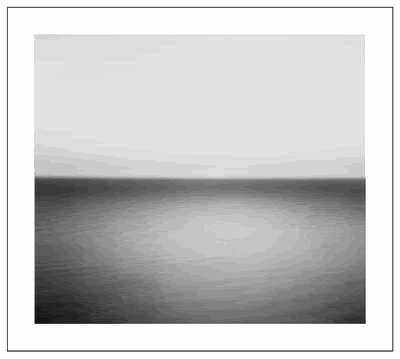21.01.2009
'Boden Sea, Uttwil'
That's the title of the image by Hiroshi Sugimoto on the cover of No Line on the Horizon. Here's the story behind it.
A month and a half before the release of No Line on the Horizon, with the first single only released to radio this week, there's a surprising level of online chat about... the album cover design. We thought we'd find out a little more.
The artwork, designed as usual by the team at Four5One in Dublin, features a seascape by the renowned Japanese artist and photographer, Hiroshi Sugimoto, who has known Bono for several years. (One of his works hangs in the band's management offices.) One of a few contemporary photographers who continue to work with traditional photographic techniques such as the silver gelatine process and the use of long exposures, the horizon is a central motif in Sugimoto’s 'Seascapes' collection. He's travelled the world to stand on remote cliffs overlooking oceans, capturing the light and atmosphere and the way these effects play in front of the horizon, which always precisely bisects his frame. His work has touched millions and U2 are not the first to see a symmetry between their work and his. We spoke to Shaughn McGrath at Four5One to ask how the design came together.
When did the idea for the album design first begin to emerge ?
The first thing that came about was the title of the record - No Line on the Horizon - that was there from the inception. Bono mentioned it to us last Spring, but at that time he didn't say too much else.
Five words isn't much to go on.
For me it inspired an atmosphere. There's something about how all of us are deeply drawn to looking out across the sea – to the horizon – that draws strong memories and feelings of time and place. There's also this sense in the title of removing barriers, a longing for purity and beauty and the unspoilt... a longing to return to a perfect moment.
Did Bono give you anything else to go on ?
He did, he talked to us about this Japanese photographer/artist who he loved, Hiroshi Sugimoto, and in particular he wanted us to look at his seascapes. That was really useful as it gave us some kind of reference for thinking about the look of the record. At that stage, when a record is nowhere near finished, the band will often talk about ideas they are working on, many of which can change when they actually get nearer the end of writing and recording. But telling us about Sugimoto's seascapes was really helpful, from them we sensed this remarkable synergy with the title of the album.
You decided to work with one particular image, 'Boden Sea, Uttwil', for the album cover.
We felt it was such an emotive image, that there was a natural coherence with the album's themes, that suggested release. And so we set this beautiful, velvet image of Sugimoto's very simply in a white surround.
Does that explain your very spare approach to the album design? It doesn't even have the album title.
It's unusual this but when we had our first meeting with the band to show our design proposal, we showed them this cover execution and they said 'Yes'. I added, 'You know it doesn't even have the title on it?' And they still said 'Yes'. The thing is that each of them in the band is very visually switched on, they all have strong design ideas and I think they realise that there are many ways of giving an album its name, it doesn't just have to be by putting it on the sleeve of the record. It's a cliche but it's true - you can sometimes say much more with far less.
What's the story on the 'equals' sign ?
The equals sign exists on its own, it isn't embedded in the image, but associated with it, on a different plane. It adds to the album's visual idiom. Whatever the culture and language spoken, this universal mathematical symbol is understood, and so it complements the clarity of expression in the image. What we love about the equals sign is the simplicity, the purity - like the title, No Line on the Horizon.
A few days after the album design was revealed, there were some stories online noting that the image had been previously used as an album cover ?
I've just heard about that album and its cover. But I think we're doing something different with Sugimoto's image, something uniquely connected with this latest body of work from U2. And while I'm pleased we've been able to do something that has so few brushstrokes and yet says so much, the response to the design of an album is connected with how well people connect with the album. To give you an earlier example, the first album I worked on with U2 was Achtung Baby in 1991 - that sleeve is widely admired, but probably because the album is so great. People love that cover because they came to love the album. These things don't exist in isolation. It's all connected to the music.
Talking of which, you've heard the finished album now, what do you think ?
I'm blown away by it, and pleased as punch for the band. Their ability to make such beautiful music, with such refreshing, interesting sounds never ceases to amaze me, something that makes the role of the designer all the more challenging and exciting.














